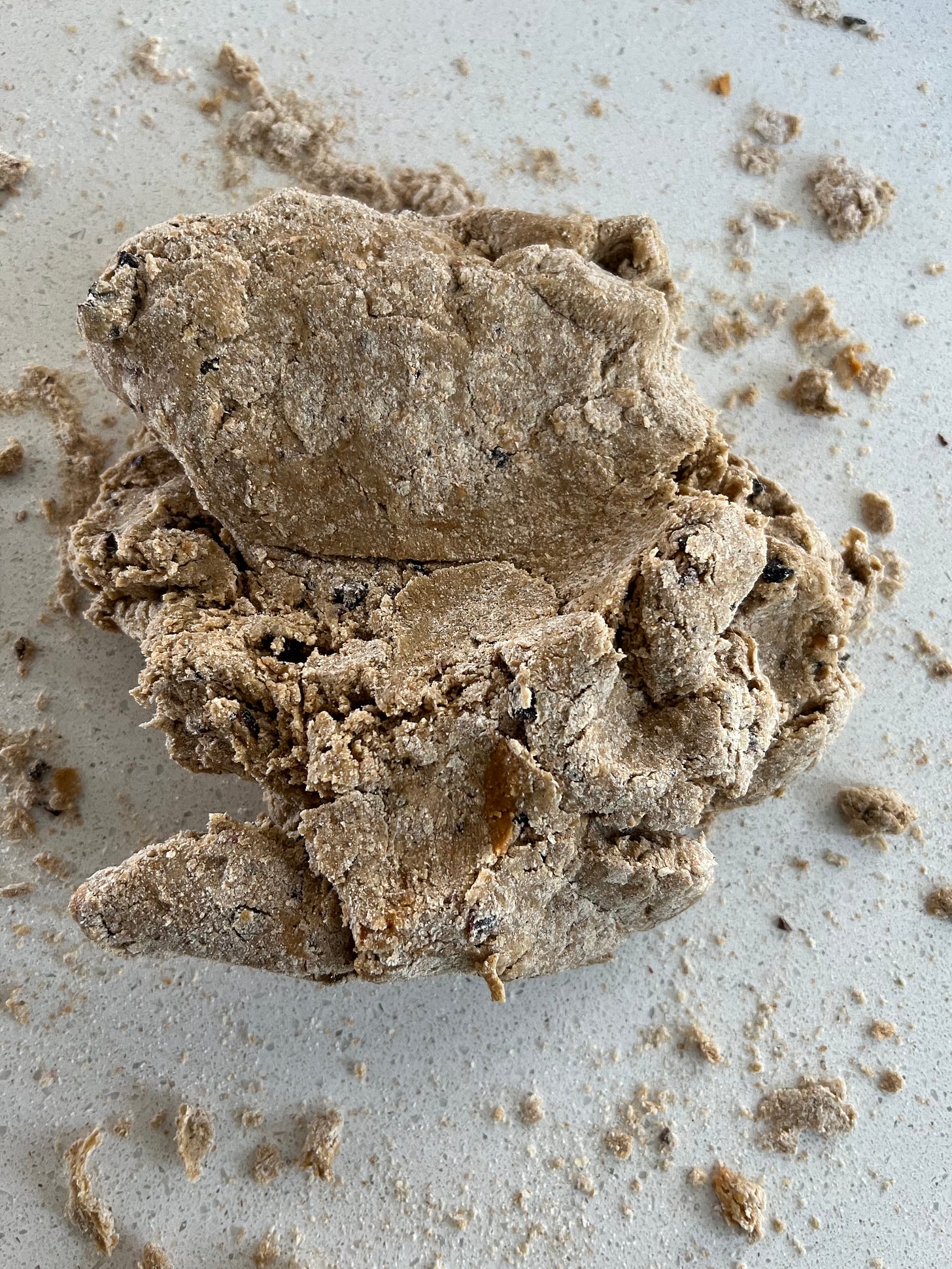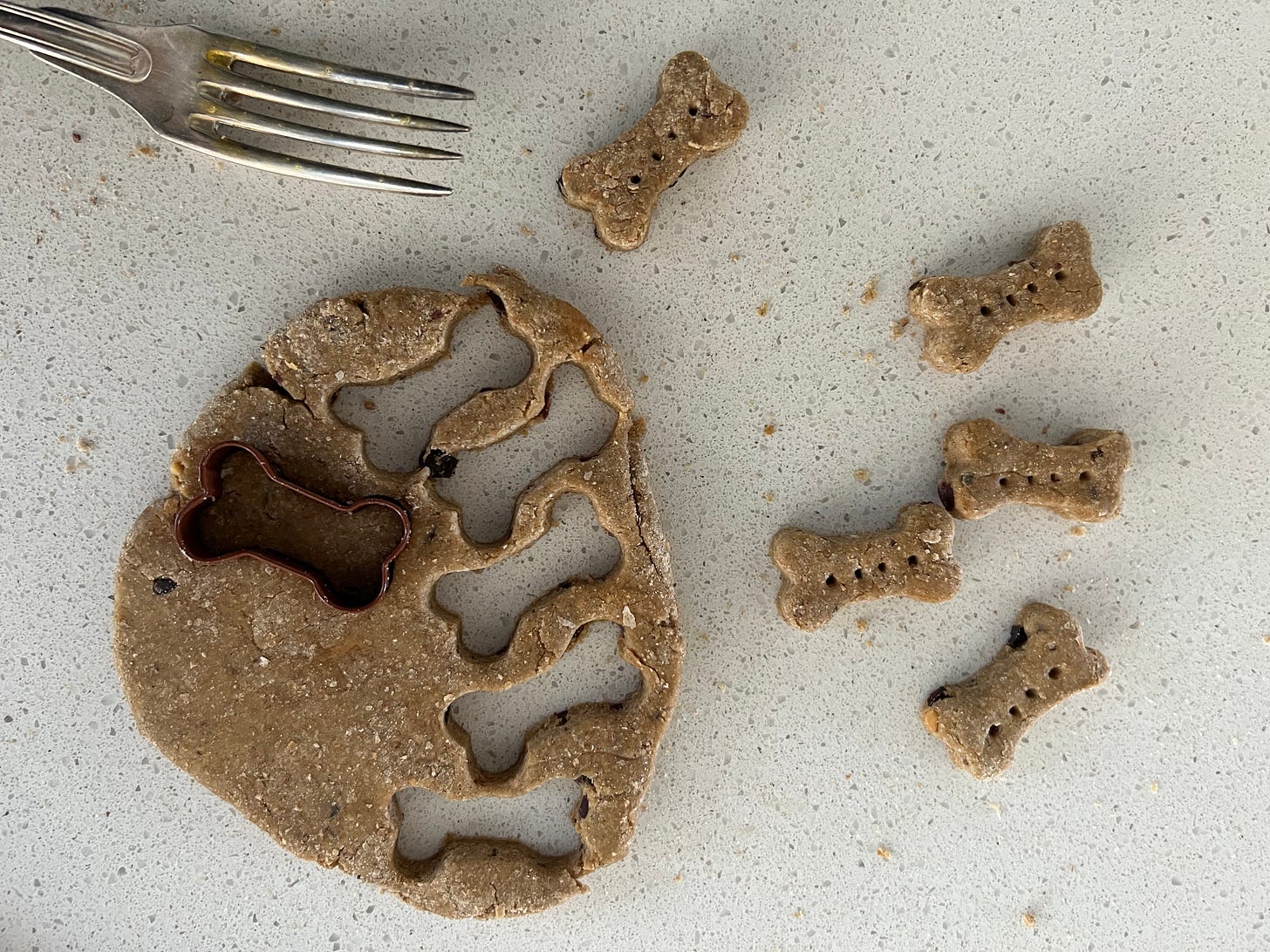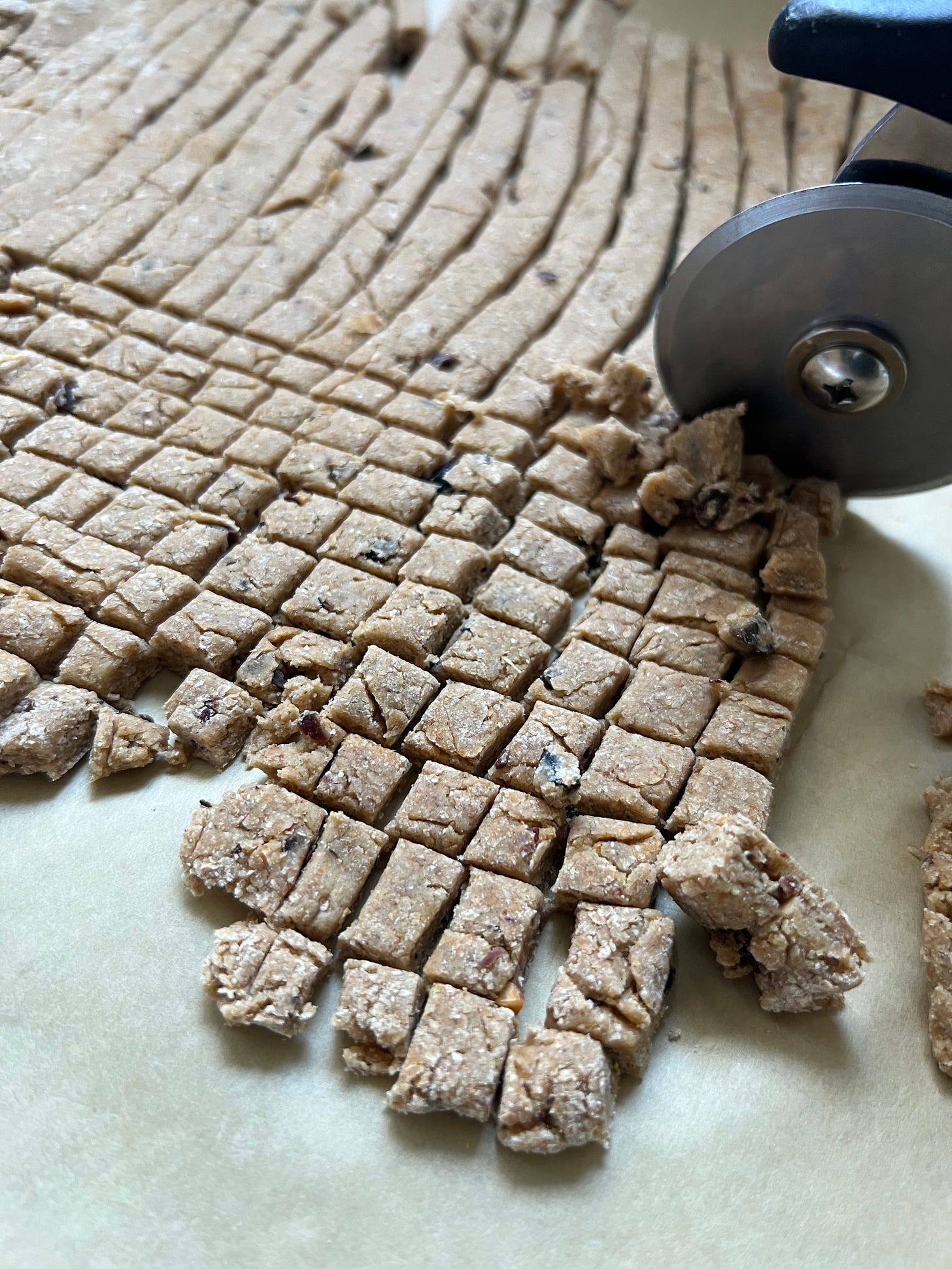Dog's Life: Homemade Treats for Your Pooch and Friends
Why I Love Milo But Don't Cook for Her: Do I Make Dog Treats Because I Love Her or Because I Don't Want to Waste Ingredients?
Issue #47 has really gone to the dogs, in more ways than one. After what I thought was just a bad head cold and two negative antigen tests, it turns out I really do have COVID-19, confirmed by a PCR and subsequent rapid test. Thanks to vaccines plus booster, I’m fortunate to have a mild case of what my doctor deemed “classic Omicron,” that is, no fever, no aches and pains, no loss of taste (phew!), mostly congestion, cough, and sore throat. It’s felt like a bad cold, and staying home, isolating, and cooking, has made me feel like I’m back in elementary school. Whenever I was home sick (and sometimes when I only pretended I was) I would watch cooking shows and cook all day. Nevertheless, this coronavirus pandemic is still deadly serious. You can bet I will still be wearing a mask on planes and public transit and any time I’m going to be in potential contact with strangers. Luckily, I had decided on the topic for this week’s newsletter before my symptoms presented, after a suggestion from my husband Nate. Last week, as our stash of treats for our puppy Milo was running down, he asked, “Have you written about these dog treats yet? She really loves them. They’ll be popular.” So this issue was born: homemade dog treats. Thank you Nate, thank you Milo, and thank you for your continued support. —Mitchell
I know not everyone is a dog person. Heck, I’m not even a dog person. And yet, I find myself in love with a Bernedoodle puppy named Milo, who is almost 2 1/2 years old—how time flies when you’re in a pandemic. She really is a bundle of happiness, full of love and joy. She’s excited to meet new people. She loves being with other dogs. She only chews her own toys (to shreds), never our shoes or anything around the house. Of course, she can be annoying and smelly. She is a dog, after all. We wish we could leave her alone for more than 20 minutes without her devolving into an emotional, anxiety-ridden wreck. #pandemicpuppy But no one is every happier to see us than Milo. For the most part she proves the “best friend” point.

Although I’ve been reminded many times by friends that I put in my wedding vows that one day I would let Nate bring a dog into our lives, it took almost 15 years and one failed attempt at a greyhound rescue before Milo arrived, coincidentally three days after lockdown in 2020—we had been on a waitlist for more than year. Still, I had rules:
No sleeping in our bed!
No sitting on our “important” original, mid-century modern, family heirloom chairs!
Given how much I like to cook, friends are surprised that I don’t cook all of Milo’s food. There are a few reasons. For one, she arrived with a very sensitive stomach that took us weeks to figure out how to control. During that period, I poached chicken breast and steamed rice for her, but that didn’t help. When we finally found a prescription dog food that didn’t upset her GI tract, we stuck with it.
Second, to say she doesn’t have a discerning palate is an understatement. She will eat just about anything off the streets of New York City if you let her: chicken bones, pieces of pizza, vomit from drunken neighborhood barhops, tennis balls. I will spare you the details of what we’ve come to call “Burrito-gate.” Milo’s favorite snack of snacks is a wooden stick, but not any wooden stick, mind you, just the one we wouldn’t let her have from here or there or the forest next to the house we are renting on Cayuga lake. None of this makes me want to go to too much effort to tantalize her tastebuds.
But there is one exception that I will share with you now: these dog treats. Here’s the thing, when you are training a new dog or trying to get her to do anything, really, you go through a lot of treats. There are all kinds of treats on the market, clearly designed to appeal to their owners more than the dogs. There are organic treats, keto treats, gluten-free treats, and others. They all seem stupidly expensive and unnecessarily packaged. In our case, I’ll remind you they are promoted for an animal that will lick a New York City sidewalk until you drag her away.
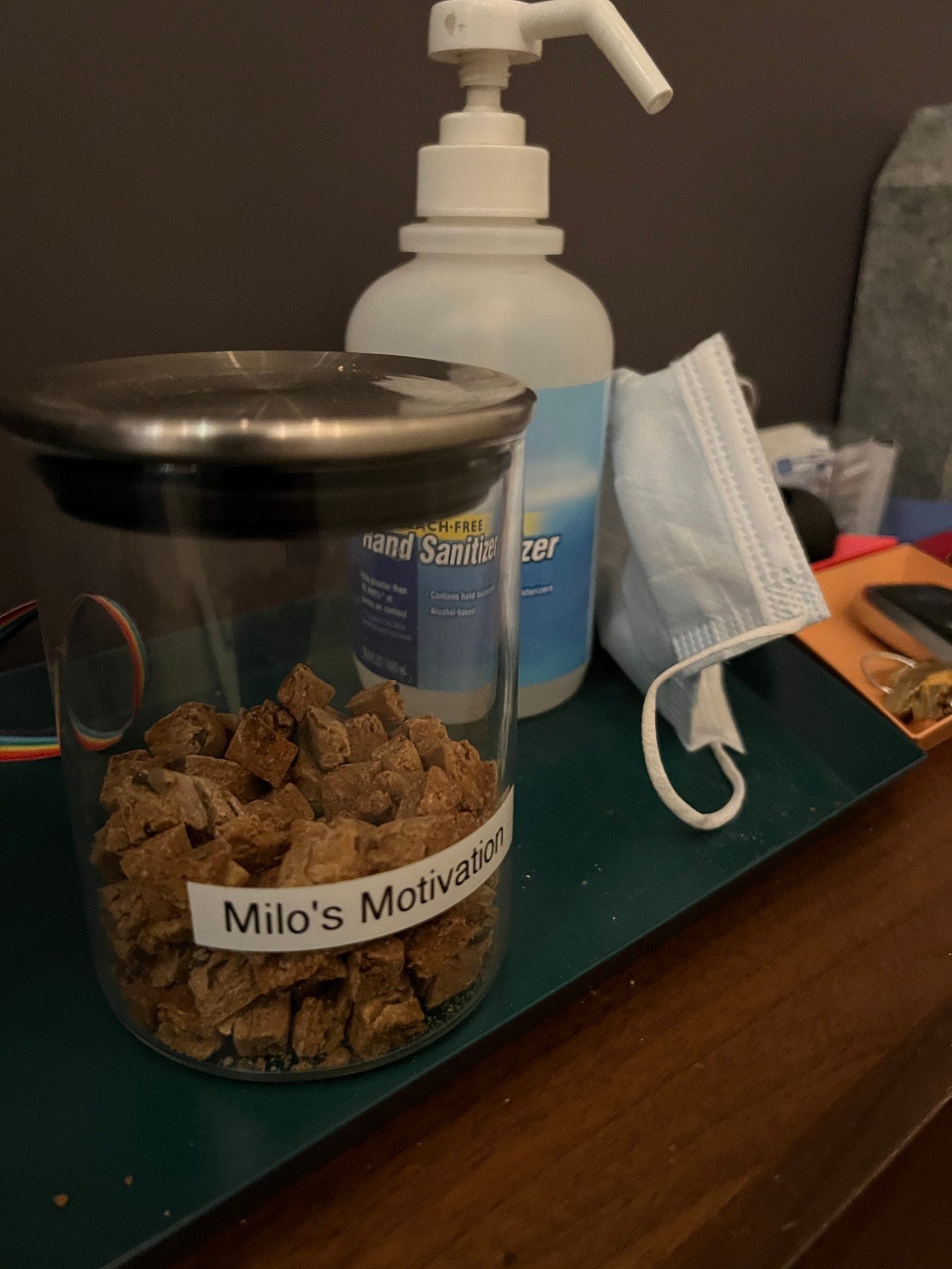
…and the Kitchen Sink
What’s more, I’ve learned that making dog treats is a great way to use up all kinds of stuff you have lying around the house. That includes sourdough discard, which we always have, as you know, but also bags of various flours you purchased to bake for your gluten-free friends but haven’t used since, myriad packs of jerky you’ve been given by your paleo-keto friends, stale granola bars you received in gift bags from events you don’t remember, whole-grains that have gone rancid, cookies made with crickets that someone thought would be “cool to try,” powdered, low-fat peanut “butter” you thought could be useful in baking, even dog treats that your dog doesn’t like on their own. Precise measurement is not necessary, either. Remember, you are cooking for a dog. Your dog’s appreciation of flavor and texture is different from a human’s. As long as you can dry the treats out enough to be crunchy, they will like them.
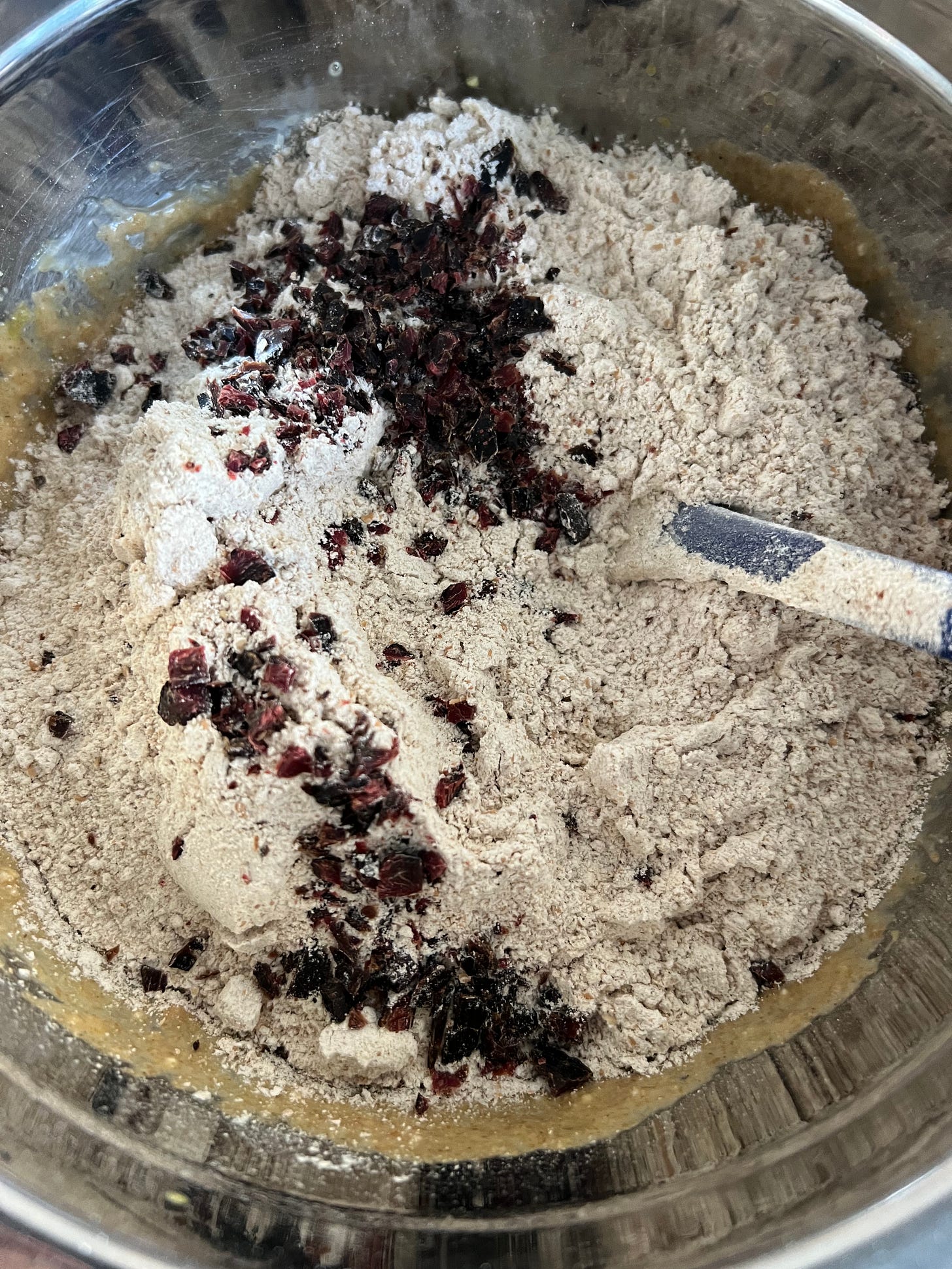
It’s important to always check that whatever you are incorporating in your treats is okay for a dog to eat. On this subject, Nate and I have different risk tolerance levels. I don’t believe a grape, a chocolate chip, or stray piece of onion will kill Milo. But you can make your own assessment. The American Kennel Club website is a good place to start.
Here is a versatile recipe for dog treats that I adapted from an original dog biscuit recipe by Marion in Cunningham in the Fannie Farmer Baking Book, from where so many delicious things come. (Yes, I have tasted these treats…by accident.) I know they are popular with dogs besides Milo because I have given them as gifts to people who always ask for the recipe. Dogs won’t leave my pants alone when I have them in my pockets at the dog park (yes, we have dog treats in all of our pockets now…ew). These treats are so good I even made a new friend with them. A very talented Israeli chef in our neighborhood, Amitzur Mor of Barbounia, saw the treats on my Instagram feed and offered to barter hummus with me for some treats for his new puppy. We’ve been friends ever since. (New York City really is a collection of small villages.)
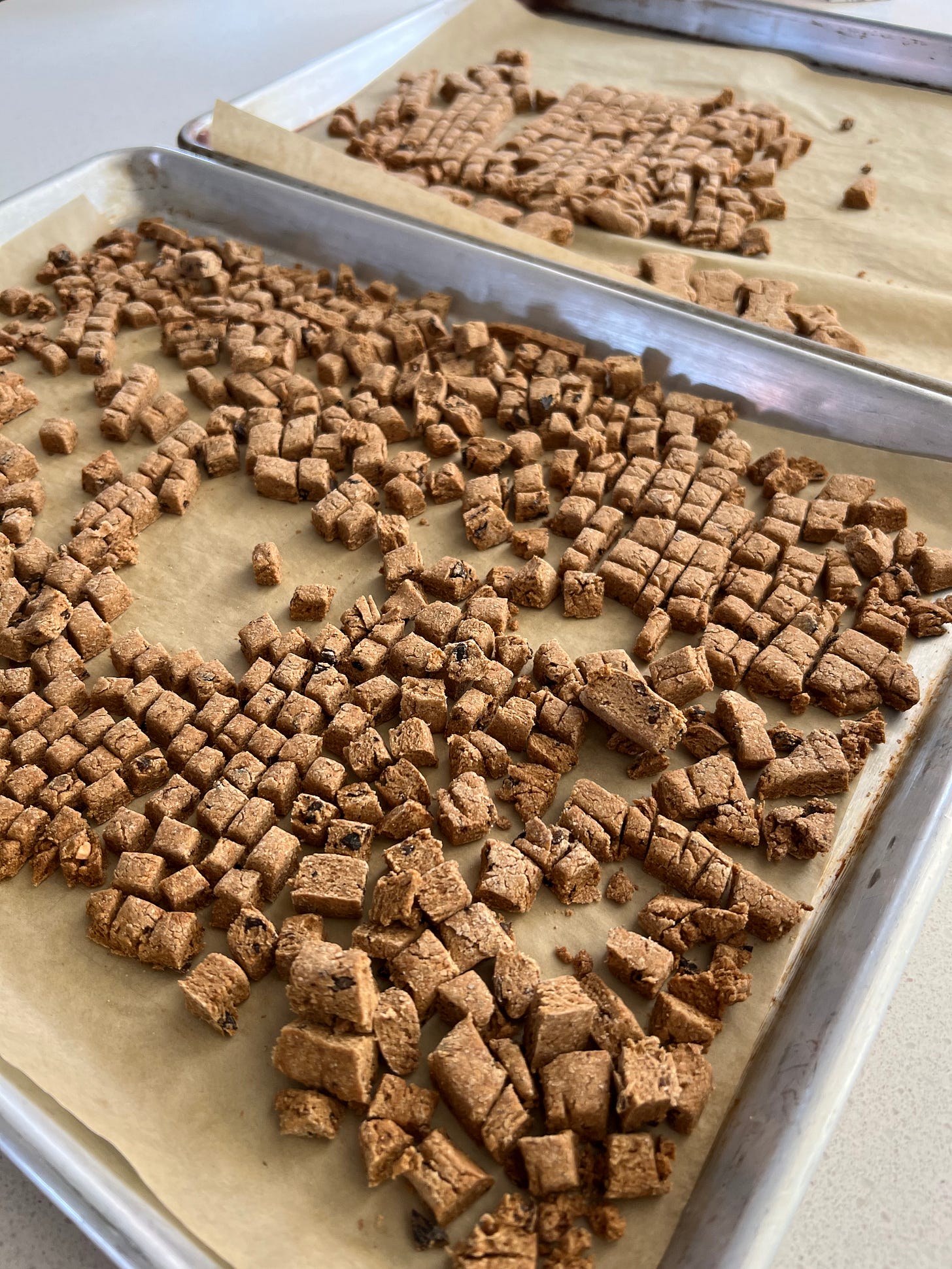
RECIPE: Kitchen-Sink Dog Treats
The yield will depend on how you shape them. This recipe can be rolled out and cut with a bone-shaped cookie cutter of various sizes, depending on the size of your dog and whether these are going to be used as special rewards. You’ll get anywhere from 3 to 6 dozen biscuits depending on the size of your cutters. Don’t be concerned about re-rolling the dough. That can make cookies unpleasantly tough for humans, but for dogs toughness is a good thing. More often, I like to cut these into tiny 1/4-inch cubes to use more like training treats. This way you get 6 or 7 cups of treats. I keep them frozen in small snack-sized bags to stay fresh until we need to replenish the “Milo’s Motivation” jar by the door.
2 large eggs, beaten
2 tablespoons bacon, duck, chicken, beef, or pork fat, or butter, melted and cooled, or olive oil
1 cup sourdough starter discard (if you don’t have any, use less flour below and substitute 1/3 cup water)
2 tablespoons natural peanut butter, smooth or chunky (powder also works)
2 tablespoons nutritional yeast
2 tablespoons nonfat dry milk powder
1/2 teaspoon fine sea salt
2 to 2 1/2 cups whole wheat flour or a combination of other flours, such as rye, spelt, rice, durum wheat, cassava, sorghum, or whatever you have around
1/4 cup cooked bacon, or ham, or hot dogs, or dried liver, or beef jerky, or tuna jerky, or other treats, or crickets, or what have you, chopped fine
Preheat the oven to 350°F. In a medium bowl, use a large fork or wooden spoon to beat together the eggs with the fat, sourdough starter or water, peanut butter, nutritional yeast, milk powder and salt until smooth. Sometimes the peanut butter clumps, so be sure to really mix well. Pressing it against the side of the bowl with the back of a spoon or spatula can help break it up. Stir in 2 cups of the flour(s) and the chopped bacon or whatever you are using for “chips.” Mix until everything is blended and no dry flour remains. The dough should be quite stiff and not sticky. Add more flour, if necessary, to get there. It can help to turn it out onto the counter to knead it all together, sort of like pasta, thought not quite as stiff, but you only have to work it until all the flour is incorporated. Divide the dough in half.
If making biscuits, roll out half the dough on a lightly floured surface until about 1/4 inch thick for small bones or other shapes, or 1/2-inch thick for larger ones. Cut out the shapes and place them on an unlined, uncreased cookie sheet. Repeat with the remaining dough, rolling and re-rolling it out to use it all up. You should discard no scraps. Prick each biscuit once or twice with the tines of a floured fork to ensure even cooking. Bake for 25 minutes, then turn the biscuits over, and bake for 25 minutes more. Turn off the heat, prop the oven door open with a wooden spoon, and let the biscuits dry out while the oven cools. It they seem to be getting too brown, pull them out. Cool completely before storing in an airtight container or freezing until needed.
If making small training treats, roll out the first half of the dough to a little less than 1/4 inch and transfer the whole sheet to an unlined, uncreased cookie sheet. Using a pizza or pasta cutter occasionally dipped in flour, make relatively even 1/4-inch strips in one direction and then perpendicularly in the other to make tiny squares. I’ve used a ruler to help guide me in the past, but now I just do it freehand. Some of the dough may stick to the cutter, but that’s okay, just pat it down. No need to separate the treats, you’ll do that once they are baked. Repeat with the remaining dough. You won’t separate them until they are baked.
Place the pans in the preheated oven and bake for 50 minutes, rotating the pans once or twice for even cooking. Turn off the heat, prop the oven door open with a wooden spoon, and let the treats dry out while the oven cools. It they seem to be getting too brown, pull them out and let cool completely. Separate the treats where they are cut. This takes a little time, but I find it meditative and usually Milo is nipping at the counter to try to get some. Store in an airtight container or freeze until needed.





